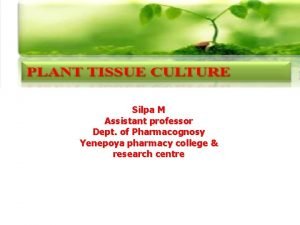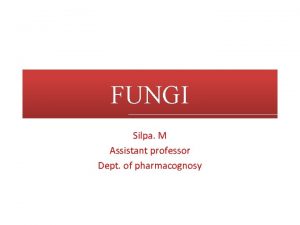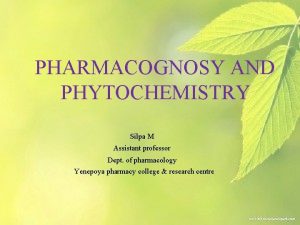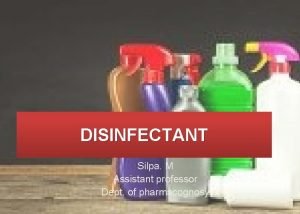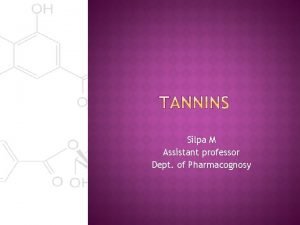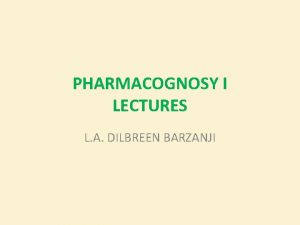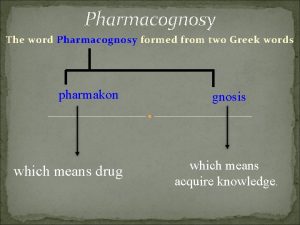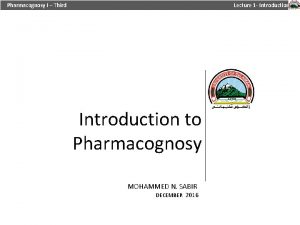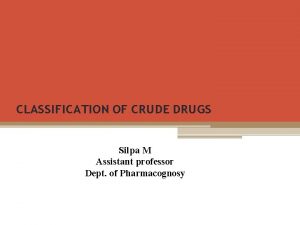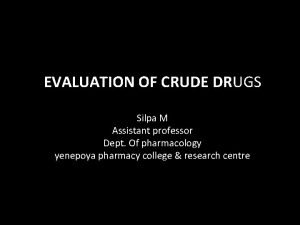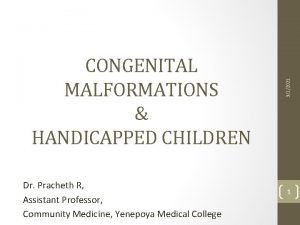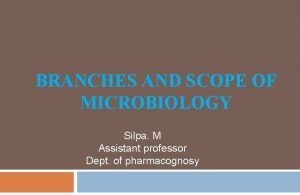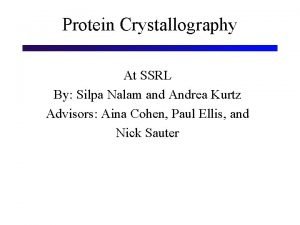Silpa M Assistant professor Dept of Pharmacognosy Yenepoya





















- Slides: 21

Silpa M Assistant professor Dept. of Pharmacognosy Yenepoya pharmacy college & research centre

• A vaccine is a biological preparation that improves immunity to a particular disease. • Vaccine: 'aword derived from usage of cowpox (cow means vacca - Latin). • It contains an agent that resembles a disease-causing microorganism and is often made from weakened or killed forms of the microbe, its toxins or one of its surface proteins. • The agent stimulates the body's immune system to recognize the foreign antigen, destroy it. • Edward Jenner (1796) used this vaccine in human beings resulting in protection of human beings from smallpox. Jenner's work was continued by Louis Pasteur.

Vaccine: Definition 1. A disease antigen that stimulates the body to produce an antibody reaction but it is not strong to produce the disease‟s harmful effects. 2. A vaccine is a biological preparation that establishes or improves immunity to a particular disease.

• In the edible vaccine, Transgenic plants are used as vaccine production systems. • The genes encoding antigens of bacterial and viral pathogens can be expressed in plants in a form in which they retain native immunogenic properties. • Initially thought to be useful only for preventing infectious diseases, it has also found application in prevention of autoimmune diseases, birth control , cancer therapy, etc. • Edible vaccines are currently being developed for a number of human and animal diseases. • As Hippocrates said , Let “thy food be thy medicine”

1. Tobacco 7. Soybean 2. Potato 8. Alfalfa 3. Banana 9. Muskmelon 4. Tomato 10. Carrot 5. Rice 11. Peanuts 6. Lettuce 12. Wheat 13. Corn

Needle free • Oral vaccines provide “mucosal immunity” at various sites by secreting antibodies. • Don‟ t need to worry about re-use, misuse and lack of sterilization. Thus, low risk of infection. • Estimated cost of $0. 005 to grow antigen for one dose of hepatitis B vaccine in an unprocessedform. Cheap • Administering oral vaccines would require little or no training at all.

• Heat-stable; do not require cold-chain maintenance. storage • If the local/native crop of a particular area is engineered to produce the vaccine, then the need for transportation and distribution can be eliminated. • Most importantly, they trigger the immunity at the mucosal surfaces such as mouth which is the body’s first line of defense. safe • Needs no purification. • Edible vaccine activates both mucosal and systemic immunity

MODE OF ACTION • The goal of oral vaccination is to stimulate the mucosal and systemic immunity against pathogen. • Edible vaccine when taken orally undergoes the mastication process and the majority of plant cell degradation occur in the intestine as a result of action of digestive or bacterial enzyme on edible vaccine. • Peyer‟s patches (PP) are an enriched source of Ig A producing plasma cells and have the potential to populate mucosal tissue and serves as mucosal immune effector site.

• The breakdown of edible vaccine near PP , consisting of the 30 -40 lymphoid nodules on the outer surface of intestine and contain follicles. • These follicles act as the site from which antigen penetrates the intestinal epithelium , thereby accumulating antigen within organized lymphoid structure. • The antigen then comes in contact with M-cell. • M cell passes the antigen to macrophages and B cell. • These B cell activates the T cell to provide immune response. • In this way the immunity is activated by the edible vaccine.

William, 2000

William, 2000

• Two ways …… • In one case , the entire structural gene is inserted into plant transformation vector between 5‟and 3‟regulatory element ; this will allow the transcription and accumulation of encoding sequence in the plant. • In the second case , epitope within the antigen are identified , DNA fragment encoding these can be used to construct gene by fusion with a coat protein gene from plant virus e. g. TMV or CMV.

Mishra et al. , 2008 Production of edible vaccine antigen in plant tissue

1. Plasmid vector carrier system : Agrobacterium tumefaciens method. 2. Micro projectile bombardment method. 3. Electroporation method.

William, 2000

ADVANTAGES 1. Edible vaccines have efficient mode of action for immunization, as they do not require subsidiary elements to stimulate immune response 2. Edible vaccines unlike traditional vaccines bring froth mucosal immunity 3. Edible vaccines are comparatively cost effective, as they do not require cold chain storage like traditional vaccines 4. Edible vaccines offer greater storage opportunities as they seeds of transgenic plants contain lesser moisture content can be easily dried. In addition, plants with oil or their aqueous extracts possess more storage opportunities 5. Edible vaccines do not need sophisticated equipments and machines as they could be easily grown on rich soils and the method is economical compared to cell culture grown in fomenters.

6. Edible vaccines are widely accepted as they are orally administered unlike traditional vaccines that are injectable. Thus, they eliminate the requirement of trained medical personnel and risk of contamination is reduced as they do not need primices and manufacturing area to be sterilized. 7. Edible vaccines offer great opportunity for 2 nd generation vaccines by integrating numerous antigens, which approach M cells simultaneously 8. Edible vaccines are safe as they do not contain heat- killed pathogens and hence do not present any risk of proteins to reform into infectious organism 9. Edible vaccine production process can be scaled up rapidly by breeding

Limitations of edible vaccines Following are some major drawbacks of edible vaccines on 1. Individual may develop immature tolerance to the particular vaccine protein or peptide 2. Dosage required varies from generation to generation and, plant to plant, protein content, patient is age, ripeness of the fruit and quantity of the food eaten 3. Edible vaccine administration requires methods for standardization of plant material product as low doses may produce lesser number of antibodies and high doses are responsible immune tolerance

4. Edible vaccines are dependent on plants stability as certain foods cannot be eaten raw and needs cooking that cause the denaturation or weaken the protein present in it 5. Edible vaccines are prone to get microbial infestation example: pototo containing vaccine can last long is stored at 4 degree Celsius while a tomato cannot last long 6. Property demarcation line is necessary between ‘vaccines fruit’ and ‘normal fruit’ to avoid misadministration of vaccines which can lead to vaccine tolerance 7. Edible vaccine function can be hampered due to wash difference in the glycosylation pattern of plants and humans


 Parent portal amnuay silpa
Parent portal amnuay silpa Amnuay silpa tuition fee
Amnuay silpa tuition fee Scope of pharmacognosy
Scope of pharmacognosy Dr santhosh thomas
Dr santhosh thomas Www.yenepoya.edu.in yengage
Www.yenepoya.edu.in yengage Yenepoya physiotherapy college
Yenepoya physiotherapy college Promotion from associate professor to professor
Promotion from associate professor to professor Cuhk salary scale 2020
Cuhk salary scale 2020 Hoe dept
Hoe dept Mn dept of education
Mn dept of education Employment first ohio
Employment first ohio La geaux biz
La geaux biz Florida dept of agriculture and consumer services
Florida dept of agriculture and consumer services Central islip fire department
Central islip fire department Gome dept
Gome dept Finance dept structure
Finance dept structure Dept ind onegov
Dept ind onegov Pt dept logistik
Pt dept logistik Lafd interview
Lafd interview Liz welch mississippi
Liz welch mississippi Hjdkdkd
Hjdkdkd Rewley house continuing education library
Rewley house continuing education library






















